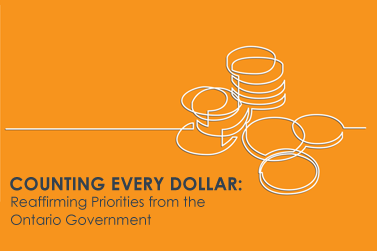Reaffirming priorities from the Ontario Government
At Optimus SBR, we regularly keep an eye on public sector developments for our clients. Our recent piece on Finding the Money: New Realities for Ontario’s Broader Public Sector discussed the new Ontario government’s priorities and what they mean for public sector leaders going forward. Now, the government’s fall economic statement, officially titled in writing as A Plan for the People – 2018 Ontario Economic Outlook and Fiscal Review, Background Papers, provides a more comprehensive picture of its priorities and what they mean for spending and the fiscal health of the province. This briefing note only addresses selected highlights from the economic statement.
The Fall Economic Statement
The Honorable Vic Fideli, Minister of Finance, presented the government’s fall economic statement in the Legislature on November 15th.[1] The mantras throughout the accompanying document are “For the People” and “Every Dollar Counts”. Indeed, immediately after the cover page and copyright details in the front matter, there is a box entitled EVERY DOLLAR COUNTS describing how the government has saved taxpayers approximately $11,000 by “only printing one-third of the typical print run” and “not formally publishing a booklet with the Minister’s Statement.” It sets a tone.
“The Fiscal Hole is Deep”
As the fall economic statement’s official title suggests, it is not a budget but rather provides an outlook and fiscal review, taking as its starting point 2017-18 actual spending figures and a “Commission Revised Baseline” for revenues, expenses and deficit figures from the Report of the Independent Financial Commission of Inquiry. That report forecast revenues of $150.9 billion, expenses of $164.9 billion, and a $15 billion deficit once a $1.0 billion reserve had been added.
The government has updated this to a Current Outlook which projects $148.2 billion in revenue, $161.8 billion in expenses, and an overall deficit of $14.5 billion. This improvement in the deficit of $0.5 billion is the net result of:
- a $2.7 billion drop in revenue, the main contributors to which are: $1.5 billion from cancelling cap-and-trade; “other changes” of $0.7 billion; and stopping planned tax increases from the previous budget of $0.3 billion; and
- a $3.2 billion drop in expenses, the main contributors to which are:
- “Savings from Expenditure Management Restrictions and Updated Forecasts” (restrictions on discretionary spending and updated program forecasts) of $1.1 billion;
- a reduction in program spending (primarily cap-and-trade, OHIP+, infrastructure spending) of $1.8 billion;
- an increase of $0.3 billion from spending on hospital and community spending, police tools, the Muskoka Watershed, and forest fire fighting; and
- $0.5 billion in “other changes”.
Fedeli says of this that “The fiscal hole is deep.” Elsewhere, the document describes principles the government will adhere to in “restoring balance” but leaves details and projections of how that will happen to the 2019 Budget. While little is said on this front, statement is setting the stage for “restoring the balance” in the future.
Distribution of Spending
Where spending is concerned, sector shares are not substantially different from the previous budget given that the fall economic statement is an update and the government has not yet had a chance to put in place a longer term fiscal plan. The government’s expected spending of $161.8 billion includes:
- $61.7 billion or 38% of the total in the health sector;
- $30.7 billion or 19% in the education sector;
- $11.4 billion or 7% in the post-secondary and training sector; and
- $12.5 billion or 8% in interest on the debt.
Highlights
There are some spending announcements and reiteration of recent ones. More importantly, the government is starting to signal directions and priorities in a variety of sectors. Below are some highlights.
Open For Business
The government includes a variety of initiatives under its Open for Business umbrella, including:
- repealing the more onerous provisions of and proposing amendments to Bill 148, the Fair Workplaces, Better Jobs Act, 2017 and introducing Bill 47, the Making Ontario Open for Business Act;
- limiting the increase in the minimum wage to $14/hour
- reducing Workplace Safety and Insurance Board (WSIB) premiums;
- cancelling Ontario’s cap-and-trade program;
- cutting red tape, with a target of reducing regulatory red tape by 25% by 2022; and
- winding down the Ontario College of Trades.
Agency and Tribunal Reviews
The new government is:
- establishing task force to review agencies and ensure they are relevant, efficient, effective and provide value for money, conspicuously mentioning the Ontario Geographic Names Board and the Rabies Advisory Committee; and
- planning to review adjudicative tribunals and tribunal clusters under the Ministry of the Attorney General.
Financial Market Regulation
The government announced that it will:
- play a leadership role in implementing the Cooperative Capital Markets Regulatory System (CCMR);
- respect the recent decision of the Supreme Court of Canada in pursuing streamlined capital markets regulation;
- propose to amend Ontario capital markets legislation to regulate benchmarks like the Canadian Dollar Offered Rate (CDOR) and Canadian Overnight Repo Rate Average (CORRA) that underpin tens of thousands of financial contracts;
- introduce legislative amendments that would provide for the amalgamation of the Deposit Insurance Corporation of Ontario (DICO) and the Deposit Insurance Reserve Fund with FSRA, the Financial Services Regulatory Authority of Ontario, to simplify the regulatory landscape.
Energy
The fall economic statement highlights that:
- the government is cancelling 758 renewable energy contracts to help reduce electricity bills by 12 per cent;
- it will be reviewing industrial electricity prices;
- it is encouraging consolidation in the electricity distribution sector with private sector involvement;
- it is closing the Thunder Bay Generating Station following announcements from Ontario Power Generation (OPG) and the Independent Electricity System Operator (IESO) to save $45 million; and
- the Ontario Energy Board (OEB) is conducting a review of its customer service rules and exploring its mandate, role and structure through the OEB Modernization Review Panel.
Health Care
The statement reiterates the government’s commitment to health care transformation, integrated care, and ending hallway medicine with advice from the Premier’s Council led by Rueben Devlin. Other highlights include:
Hospitals
- $90 million for 1,100 beds and spaces in hospitals and the community, including the creation of over 640 new beds and spaces as an immediate measure
Mental Health and Addictions
- $1.9 billion over 10 years on mental health and addictions services;
- spending to reduce wait times, faster access;
- a new Consumption and Treatment Services model; and
- funding to expand the scope and coverage of Rapid Access Addiction Medicine (RAAM) clinics for people with substance abuse issues.
OHIP+ and Ontario Drug Benefit Program
- Children and youth under 25 who are covered by private insurance will bill those plans starting in March 2019, while those who are not covered will continue to benefit from OHIP+, creating an estimated savings of $250 million; and
- a commitment to examine the Ontario Drug Benefit Program to create an easier to understand, more consistent and more sustainable drug system.
Long-Term Care
- 6,000 new beds and a commitment to invest $300 million to support them, as the first wave of over 15,000 new long-term beds over the next five years.
Municipalities
On the municipal front the government highlighted that it:
- has signed a joint Memorandum of Understanding (MOU) with the Association of Municipalities of Ontario (AMO);
- committed $40 million over two years to help municipalities with implementation of cannabis legalization, plus provide municipalities that have not opted out of retail stores by January 22, 2019 with 50% of the federal excise duty exceeding $100 million in the first two years;
- will launch a Housing Supply Action Plan and undertake measures to increase the supply of housing across Ontario.
Transportation and Transit
The government announced it:
- will be completing a review of all transportation and transit capital projects;
- will develop a plan to upload responsibility for the Toronto Transit Commission (TTC) subway infrastructure from the City of Toronto to the Province;
- undertaking planning work with respect to high-speed rail in the province, particularly Southwestern Ontario;
- is working to resume the Environmental Assessment for the Greater Toronto Area West Highway Corridor, covering portions of York, Peel and Halton regions.
- is planning to propose amendments to the Metrolinx Act, 2006 to modernize Metrolinx, consistent with its broader agency review.
Alcohol and Cannabis
On these two fronts, the government:
- will undertake a comprehensive review of the beverage alcohol sector and expand the sale of beer and wine into corner stores, grocery stores, and big-box stores;
- established the Alcohol and Gaming Commission of Ontario (AGCO) as the regulatory for private cannabis retail stores;
- has aligned cannabis consumption rules with the Smoke-Free Ontario Act, 2017 restrictions, so that smoking and vaping cannabis is prohibited near schools, children’s playgrounds, hospitals and child care facilities, among others; and
- intends to introduce legislation to amend the Municipal Act, 2001, and the City of Toronto Act, 2006to clarify municipalities’ authority in the cannabis area.
Discussion: It’s About Priorities Right Now
There is of course more in this economic statement, and surely much more in the spring budget to come. As we said in Finding the Money: New Realities for Ontario’s Broader Public Sector, all indications are that the budget cuts the government has touted are to be taken seriously, and may be even greater in non-core areas.
But this update is less about revenue and spending announcements than about signalling broad directions and priorities. It will be important to be aware of going forward, as the hard work for everyone in the Ontario public sector is yet to come.
In the meantime, if you need help preparing for this hard work, give us a call, or send us a note.
Brad Ferguson, SVP, Industries and Government Practice
Brad.Ferguson@optimusssbr.com
416.649.9184
David Lynch, Principal
David.Lynch@optimussbr.com
[1] Excerpts in bulleted form below preserve or paraphrase the Fall Economic Statement’s wording to ensure accuracy and clarity.

Optimus SBR Celebrates 6 Consecutive Wins as 2024 Best Workplaces™ in Professional Services
Our commitment to a people-first approach has been central to being recognized in 2024 for the sixth time as one of the Best Workplaces™ in Professional Services and the key to our overall success.

12 Best Practices to Increase Cross-Team Collaboration and Enhance Organizational Alignment
Enhancing cross-team collaboration drives innovation, optimizes resources, improves overall performance, and ensures every part of your organization works toward the same goals.

Enhancing Your Data Strategy for Success: The Power of Metadata
Metadata goes beyond just aiding in data retrieval. It ensures your data is secure, compliant and, most importantly, understood consistently by everyone in the organization.

Optimizing Language Translation Strategies: Beyond Compliance to Enhanced Operational Efficiency
The introduction of Quebec’s Bill 96 in Canada underscores the necessity for comprehensive translation strategies. Integrating machine translation technologies helps meet regulatory requirements while enhancing translation speed, cost efficiency, and operational effectiveness.

How to Manage Gen Z: 16 Strategies to Engage and Retain Young Talent
These practical strategies lead to a workplace that is better aligned with the values and expectations of Gen Z employees, ensuring that your efforts to attract and retain Gen Z talent are both successful and sustainable.

How to Measure the Success of Learning and Development: 12 Important Metrics to Evaluate
Quantifying the success of L&D training programs can be challenging. Learn about selecting and measuring the right metrics to determine whether your training efforts are truly making an impact.



